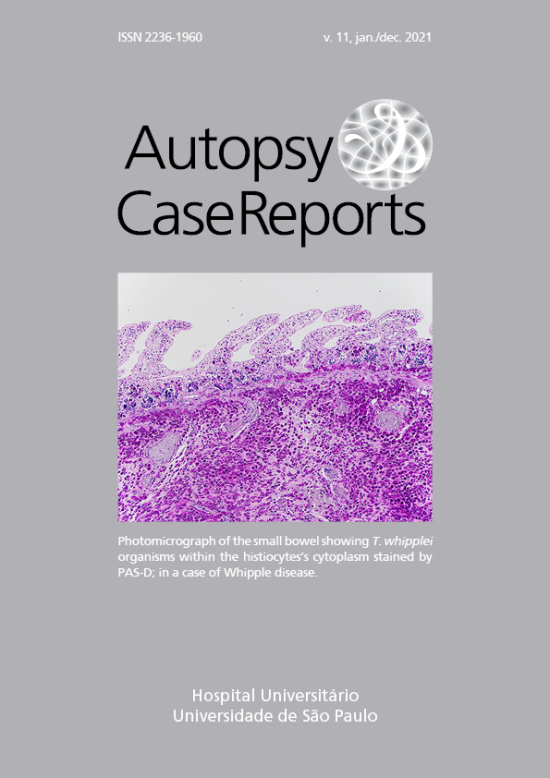An unusual case of adamantinoma of long bone
DOI:
https://doi.org/10.4322/acr.2021.276Keywords:
Adamantinoma, Diaphyses, TibiaAbstract
Adamantinoma of the long bones is an exceedingly rare and slow-growing tumor that affects the diaphysis of long bones, particularly the tibia. Based on the pattern of the epithelial cell component and the presence or absence of the osteofibrous dysplasia-like element, several histological variants have been described, such as (i) tubular (the most frequent), (ii) basaloid, (iii) squamous, (iv) spindle variant, (v) osteofibrous dysplasia –like variant, and (vi) Ewing’s sarcoma – like adamantinoma (the least frequent). The diagnosis may be challenging since this tumor may be mistakenly interpreted as carcinoma, myoepithelial tumor, osteofibrous dysplasia, and vascular tumor. We report the case of a 41-year-old male who presented with swelling over the right leg associated with pain. The X-ray showed a lytic lesion of the right-sided tibia. The diagnosis of adamantinoma was made based on the clinico-radiological, histomorphology, and immunohistochemical findings. Histologically, classic adamantinoma is a biphasic tumor characterized by epithelial and osteofibrous components in varying proportions and differentiating patterns. The diagnosis can be confirmed by immunohistochemistry for demonstrating sparse epithelial cell nests when the radiological features are strongly consistent with adamantinoma. This case is highlighted because the epithelial component can lead to a misdiagnosis, particularly when the clinico-radiological features are overlooked. Adamantinoma of long bones has the potential for local recurrence and may metastasize to the lungs, lymph nodes, or other bones. The prognosis is good if early intervention is taken.
Downloads
References
Amin MB, Buckley CH, Anthony PP. Chapter title [[Q1: Q1]]. In: Fletcher CDM, Diagnostic histopathology of tumors. 2nd ed. Edinburgh: Churchill Livingstone; 2013. p. 1576-8.
Rosai J. Adamantinoma of the tibia: electron microscopic evidence of its epithelial origin. Am J Clin Pathol. 1969;51(6):786-92. http://dx.doi.org/10.1093/ajcp/51.6.786. PMid:5770677.
Rosai J, Pinkus GS. Immunohistochemical demonstration of epithelial differentiation in adamantinoma of the tibia. Am J Surg Pathol. 1982;6(5):427-34. http://dx.doi.org/10.1097/00000478-198207000-00004. PMid:6181697.
Mori H, Yamamoto S, Hiramatsu K, Miura T, Moon NF. Adamantinoma of the tibia: ultrastructural and immunohistochemical study with reference to histogenesis. Clin Orthop Relat Res. 1984;&NA;(190):299-310. http://dx.doi.org/10.1097/00003086-198411000-00053. PMid:6207973.
Schulenburg CA. Adamantinoma. Ann R Coll Surg Engl. 1951;8(5):329-53. PMid:14830121.
Khémiri C, Mrabet D, Mizouni H, et al. Adamantinoma of the tibia and fibula with pulmonary metastasis: an unusual presentation. BMJ Case Rep. 2011;2011(1):bcr0620114318. http://dx.doi.org/10.1136/bcr.06.2011.4318. PMid:22675031.
Ramesh R, Burrah R, Thambuchetty N, Shivakumar K, Ananthamurthy A, Manjunath S. Adamantinoma of the tibia: a case report. Indian J Surg Oncol. 2012;3(3):239-41. http://dx.doi.org/10.1007/s13193-012-0168-9. PMid:23997514.
Filippou DK, Papadopoulos V, Kiparidou E, Demertzis NT. Adamantinoma of tibia: a case of late local recurrence along with lung metastases. J Postgrad Med. 2003;49(1):75-7. http://dx.doi.org/10.4103/0022-3859.923. PMid:12865576.
Luber AJ, Glembocki DJ, Butler DC, Patel NB. Metastatic adamantinoma presenting as a cutaneous papule. Cutis. 2019;104(1):E15-6. PMid:31487350.
Judmaier W, Peer S, Krejzi T, Dessl A, Kühberger R. MR findings in tibial adamantinoma: a case report. Acta Radiol. 1998;39(3):276-8. PMid:9571943.
Springfield DS, Rosenberg AE, Mankin HJ, Mindell ER. Relationship between osteofibrous dysplasia and adamantinoma. Clin Orthop Relat Res. 1994;(309):234-44. PMid:7994967.
Hazelbag HM, Taminiau AH, Fleuren GJ, Hogendoorn PC. Adamantinoma of the long bones: a clinicopathological study of thirty-two patients with emphasis on histological subtype, precursor lesion and biological behavior. J Bone Joint Surg Am. 1994;76(10):1482-99. http://dx.doi.org/10.2106/00004623-199410000-00008. PMid:7929496.
Kahn LB. Adamantinoma, osteofibrous dysplasia and differentiated adamantinoma. Skeletal Radiol. 2003;32(5):245-58. http://dx.doi.org/10.1007/s00256-003-0624-2. PMid:12679847.
Carmpanacci M. Osteofibrous dysplasia and adamantinoma: bone and soft tissue tumors. New York: Springer-Verlag Wien; 1999. p. 707-31. http://dx.doi.org/10.1007/978-3-7091-3846-5_44.
Moon NF, Mori H. Adamantinoma of the appendicular skeleton: updated. Clin Orthop Relat Res. 1986;(204):215-37. PMid:3514033.
Izquierdo FM, Ramos LR, Sánchez-Herráez S, Hernández T, Alava E, Hazelbag HM. Dedifferentiated classic adamantinoma of the tibia: a report of a case with eventual complete revertant mesenchymal phenotype. Am J Surg Pathol. 2010;34(9):1388-92. http://dx.doi.org/10.1097/PAS.0b013e3181ecfe6a. PMid:20717000.
Povýšil C, Kohout A, Urban K, Horák M. Differentiated adamantinoma of the fibula: a rhabdoid variant. Skeletal Radiol. 2004;33(8):488-92. http://dx.doi.org/10.1007/s00256-004-0755-0. PMid:14999433.
Van der Woude HJ, Hazelbag HM, Bloem JL, Taminiau AH, Hogendoorn PC. MRI of adamantinoma of long bones in correlation with histopathology. AJR Am J Roentgenol. 2004;183(6):1737-44. http://dx.doi.org/10.2214/ajr.183.6.01831737. PMid:15547221.
Jain D, Jain VK, Vasishta RK, Ranjan P, Kumar Y. Adamantinoma: a clinicopathological review and update. Diagn Pathol. 2008;3(1):8. http://dx.doi.org/10.1186/1746-1596-3-8. PMid:18279517.
Qureshi AA, Shott S, Mallin BA, Gitelis S. Current trends in the management of adamantinoma of long bones. An international study. J Bone Joint Surg Am. 2000;82(8):1122-31. http://dx.doi.org/10.2106/00004623-200008000-00009. PMid:10954102.
Bishop JA, Alaggio R, Zhang L, Seethala RR, Antonescu CR. Adamantinoma-like ewing family tumors of the head and neck: a pitfall in the differential diagnosis of basaloid and myoepithelial carcinomas. Am J Surg Pathol. 2015;39(9):1267-74. http://dx.doi.org/10.1097/PAS.0000000000000460. PMid:26034869.
Hazelbag HM, Wessels JW, Mollevangers P, van den Berg E, Molenaar WM, Hogendoorn PC. Cytogenetic analysis of adamantinoma of long bones: further indications for a common histogenesis with osteofibrous dysplasia. Cancer Genet Cytogenet. 1997;97(1):5-11. http://dx.doi.org/10.1016/S0165-4608(96)00308-1. PMid:9242211.
Jain D, Jain VK, Vasishta RK, Ranjan P, Kumar Y. Adamantinoma: a clinicopathological review and update. Diagn Pathol. 2008;3(1):8. http://dx.doi.org/10.1186/1746-1596-3-8. PMid:18279517.
Downloads
Published
Issue
Section
License
Copyright (c) 2021 Autopsy and Case Reports

This work is licensed under a Creative Commons Attribution 4.0 International License.
Copyright
Authors of articles published by Autopsy and Case Report retain the copyright of their work without restrictions, licensing it under the Creative Commons Attribution License - CC-BY, which allows articles to be re-used and re-distributed without restriction, as long as the original work is correctly cited.



